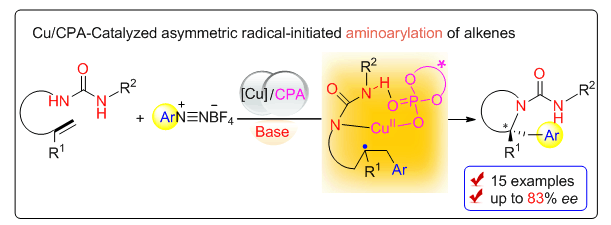| [1] (a) Royles, B. J. L. Chem. Rev. 1995, 95, 1981;
(b) O'Hagan, D. Nat. Prod. Rep. 2000, 17, 435.
(c) Lewis, J. R. Nat. Prod. Rep. 2001, 18, 95.
(d) Fish, P. V.; Andrews, M. D.; Jonathan Fray, M.; Stobie, A.; Wakenhut, F.; Whitlock, G. A. Bioorg. Med. Chem. Lett. 2009, 19, 2829.
[2] (a) Fache, F.; Schulz, E.; Tommasino, M. L.; Lemaire, M. Chem. Rev. 2000, 100, 2159.
(b) Notz, W.; Tanaka, F.; Barbas, C. F. Acc. Chem. Res. 2004, 37, 580.
(c) Erkkila, A.; Majander, I.; Pihko, P. M. Chem. Rev. 2007, 107, 5416.
(d) Caputo, C. A.; Jones, N. D. Dalton Trans. 2007, 4627.
[3] (a) Pettit, G. R.; Goswami, A.; Cragg, G. M.; Schmidt, J. M.; Zou, J. C. J. Nat. Prod. 1984, 47, 913.
(b) Su, B.; Cai, C.; Deng, M.; Wang, Q. J. Agric. Food. Chem. 2016, 64, 2039.
[4] Oloff, S.; Mailman, R. B.; Tropsha, A. J. Med. Chem. 2005, 48, 7322.
[5] Burnett, D. A.; Hart, D. J. J. Org. Chem. 1987, 52, 5662.
[6] Lebon, F.; Pegurier, C.; Ledecq, M.; Mathieu, B.; Bosman, N.; Frycia, A.; Lengele, S.; Dhurke, K.; Kanduluru, A. K.; Meunier, S.; Wagner, A.; Wolff, C.; Provins, L. Bioorg. Med. Chem. Lett. 2012, 22, 3978.
[7] For selected reviews, see:(a) Coldham, I.; Hufton, R. Chem. Rev. 2005, 105, 2765.
(b) Pandey, G.; Banerjee, P.; Gadre, S. R. Chem. Rev. 2006, 106, 4484.
(c) Pellissier, H. Tetrahedron 2007, 63, 3235.
(d) Nicolle, S. M.; Lewis, W.; Hayes, C. J.; Moody, C. J. Angew. Chem., Int. Ed. 2016, 55, 3749.
[8] For selected racemic examples, see:(a) Ney, J. E.; Wolfe, J. P. Angew. Chem., Int. Ed. 2004, 43, 3605.
(b) Ney, J. E.; Hay, M. B.; Yang, Q.; Wolfe, J. P. Adv. Synth. Catal. 2005, 347, 1614.
(c) Bertrand, M. B.; Leathen, M. L.; Wolfe, J. P. Org. Lett. 2007, 9, 457.
(d) Bertrand, M. B.; Neukom, J. D.; Wolfe, J. P. J. Org. Chem. 2008, 73, 8851.
(e) Brenzovich, W. E., Jr.; Benitez, D.; Lackner, A. D.; Shunatona, H. P.; Tkatchouk, E.; Goddard, W. A., 3rd; Toste, F. D. Angew. Chem., Int. Ed. 2010, 49, 5519.
(f) Tkatchouk, E.; Mankad, N. P.; Benitez, D.; Goddard, W. A., 3rd; Toste, F. D. J. Am. Chem. Soc. 2011, 133, 14293.
(g) Fumagalli, G.; Boyd, S.; Greaney, M. F. Org. Lett. 2013, 15, 4398.
(h) Sahoo, B.; Hopkinson, M. N.; Glorius, F. J. Am. Chem. Soc. 2013, 135, 5505.
(i) Fornwald, R. M.; Fritz, J. A.; Wolfe, J. P. Chem.-Eur. J. 2014, 20, 8782.
(j) Alicea, J.; Wolfe, J. P. J. Org. Chem. 2014, 79, 4212.
(k) Faulkner, A.; Scott, J. S.; Bower,
J. F. J. Am. Chem. Soc. 2015, 137, 7224.
(l) Peterson, L. J.; Wolfe, J. P. Adv. Synth. Catal. 2015, 357, 2339.
(m) Garad, D. N.; Mhaske, S. B. Org. Lett. 2016, 18, 3862.
(n) Yang, H.-B.; Pathipati, S. R.; Selander, N. ACS Catal. 2017, 7, 8441.
(o) Yang, M.-N.; Yan, D.-M.; Zhao, Q.-Q.; Chen, J.-R.; Xiao, W.-J. Org. Lett. 2017, 19, 5208.
(p) Zhang, R.; Xu, Q.; Shi, M. Acta Chim. Sinica 2012, 70, 1593. (张睿, 徐琴, 施敏, 化学学报, 2012, 70, 1593.)
(q) Zhang, J.; Wu, Z.; Xie, F.; Zhang, W. Chin. J. Org. Chem. 2018, 38, 1319. (张金刚, 吴正兴, 谢芳, 张万斌, 有机化学, 2018, 38, 1319.)
[9] For selected reviews, see:(a) Heinrich, M. R. Chem. Eur. J. 2009, 15, 820.
(b) Hari, D. P.; Koenig, B. Angew. Chem., Int. Ed. 2013, 52, 4734.
(c) Kindt, S.; Heinrich, M. R. Synthesis 2016, 48, 1597.
[10] For selected examples, see:(a) Sahoo, B.; Hopkinson, M. N.; Glorius, F. J. Am. Chem. Soc. 2013, 135, 5505.
(b) Hari, D. P.; Hering, T.; Koenig, B. Angew. Chem., Int. Ed. 2014, 53, 725.
(c) Kindt, S.; Wicht, K.; Heinrich, M. R. Org. Lett. 2015, 17, 6122.
[11] (a) Mai, D. N.; Wolfe, J. P. J. Am. Chem. Soc. 2010, 132, 12157.
(b) Babij, N. R.; Wolfe, J. P. Angew. Chem., Int. Ed. 2013, 52, 9247.
(c) Hopkins, B. A.; Wolfe, J. P. Chem. Sci. 2014, 5, 4840.
(d) White, D. R.; Hutt, J. T.; Wolfe, J. P. J. Am. Chem. Soc. 2015, 137, 11246.
(e) Garlets, Z. J.; Parenti, K. R.; Wolfe, J. P. Chem.-Eur. J. 2016, 22, 5919.
[12] Zhang, W.; Chen, P.; Liu, G. Angew. Chem., Int. Ed. 2017, 56, 5336.
[13] (a) Neukom, J. D.; Perch, N. S.; Wolfe, J. P. J. Am. Chem. Soc. 2010, 132, 6276.
(b) Neukom, J. D.; Perch, N. S.; Wolfe, J. P. Organometallics 2011, 30, 1269.
[14] Zhu, R.; Buchwald, S. L. J. Am. Chem. Soc. 2015, 137, 8069.
[15] Lin, J.-S.; Dong, X.-Y.; Li, T.-T.; Jiang, N.-C.; Tan, B.; Liu, X.-Y. J. Am. Chem. Soc. 2016, 138, 9357.
[16] Lin, J.-S.; Wang, F.-L.; Dong, X.-Y.; He, W.-W.; Yuan, Y.; Chen, S.; Liu, X.-Y. Nat. Commun. 2017, 8, 14841.
[17] Wang, F.-L.; Dong, X.-Y.; Lin, J.-S.; Zeng, Y.; Jiao, G.-Y.; Gu, Q.-S.; Guo, X.-Q.; Ma, C.-L.; Liu, X.-Y. Chem 2017, 3, 979.
[18] (a) Wang, F.; Wang, D.; Wan, X.; Wu, L.; Chen, P.; Liu, G. J. Am. Chem. Soc. 2016, 138, 15547.
(b) Wang, D.; Wang, F.; Chen, P.; Lin, Z.; Liu, G. Angew. Chem., Int. Ed. 2017, 56, 2054.
(c) Wu, L.; Wang, F.; Wan, X.; Wang, D.; Chen, P.; Liu, G. J. Am. Chem. Soc. 2017, 139, 2904.
[19] Cheng, Y.-F.; Dong, X.-Y.; Gu, Q.-S.; Yu, Z.-L.; Liu, X.-Y. Angew. Chem., Int. Ed. 2017, 56, 8883. |
